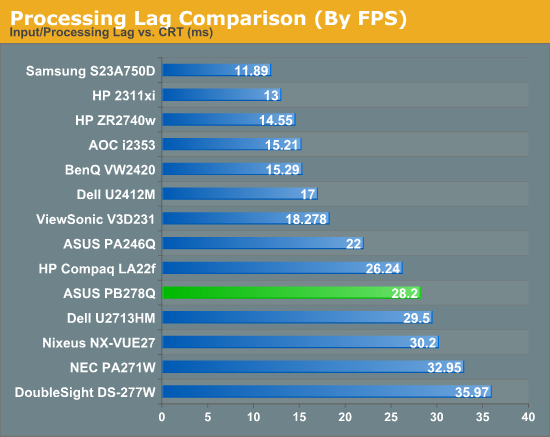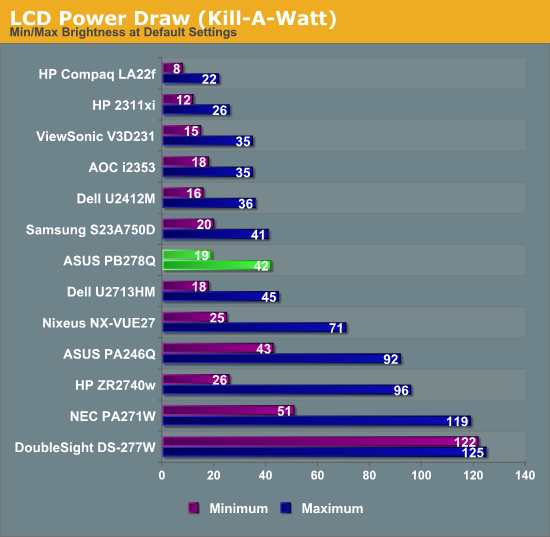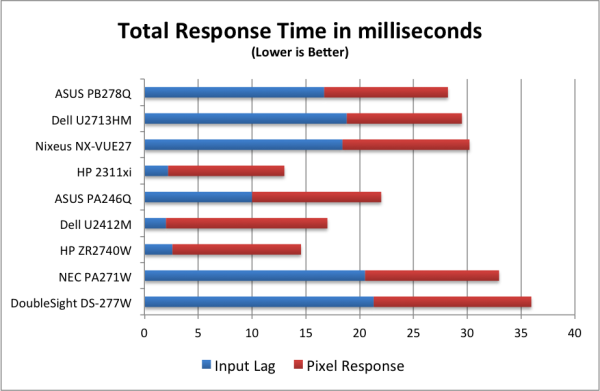ASUS PB278Q Review: An IPS Competitor Emerges
by Chris Heinonen on November 19, 2012 11:00 PM ESTASUS PB278Q Input Lag and Power Use
Unlike the prior 27” displays that we've tested, the ASUS has a 1:1 pixel mapping mode and a full stretch mode for 1920x1080 content. This finally allows me to test and see if the issue with higher lag on 27” displays is being caused by stretching the 1920x1080 signal to fill a 2560x1440 screen, or if it's the inputs and other hardware causing the issue. The lag numbers for the PB278Q are right about what we’ve been seeing for 27” displays, with 16.7 ms of input lag and 11.5 ms of response time for the pixels. This gives us a total overall delay of 28.2 ms using the DVI input. Switching from Full to 1:1 gives no change in the results at all.
Because of this, it seems that the lag in the 27” displays isn’t caused by running at non-native resolution, at least in this case, but more likely by the electronics that deal with display settings and input switching. So even if you run the ASUS at 2560x1440 instead of 1920x1080, I would guess you will see the same results for lag, which is around 1.5 frames in real-world use.

I also did some testing of the TraceFree options using the PixPerAn program to see how that impacts motion blur. The default setting is 60 (and why a control goes from 0-100 but only allows 6 settings is a whole different discussion) and that provided the best results to my eyes. Settings below that lead to more blurring of the pixels behind the car, and settings above that lead to artifacts around the car. TraceFree offers no change to the lag timing but does provide an improvement for motion blurring.
Power use on the ASUS is almost as good as I have seen on a 27” display to this point. With a full white screen it is a little lower than the Dell U2713HM, and with a black screen it is only 1 watt more. Of course the Dell has a higher level of light output than the ASUS does, so if I were to test it at 300 nits it would likely use even less power than the ASUS does for the same level of light output. This is probably only a difference of 1-2 watts at the most, so they really use the same amount of power.

Even if the Dell is the same for power use, the ASUS still uses very little power relative to almost any other 27” display out there, and it will do a good job of keeping your power draw low.











55 Comments
View All Comments
cheinonen - Tuesday, November 20, 2012 - link
I don't have the 21:9 Dell, but I have the LG EA93 being written up now.jjj - Tuesday, November 20, 2012 - link
That's great,looking forward to the review.I guess it's the same penel,Dell might use it better but the LG could be cheaper.bcseime - Tuesday, November 20, 2012 - link
The values for U2412M in the processing lag comparison graph does not match the value in the total response time graph.Avalon - Tuesday, November 20, 2012 - link
Ahh, I see you beat me to it.JarredWalton - Tuesday, November 20, 2012 - link
Had the same name twice; fixed now with the slower U2713HM correctly labeled. Thanks!dishayu - Tuesday, November 20, 2012 - link
You should probably try an include a couple of 120Hz LCDs like the Benq XL2410T, atleast in the input lag charts. I'd like to see how far behind IPS panels are, and of course, how close to CRT can a 120Hz LCD get.h107474 - Tuesday, November 20, 2012 - link
Actually they should use the Hazro HZ27WC for input lag comparison of 27" displays. It is also based on the LG panel but it's the ultra cut down cheap version with no scalars, only DVI input and no OSD at all! This means ultra low lag and is why I bought it. Check out the TFT Central review and input lag measurements below:http://www.tftcentral.co.uk/reviews/content/hazro_...
HisDivineOrder - Tuesday, November 20, 2012 - link
I agree. Input lag is quite commonly a problem with monitors with built-in scalers. But then, that was true years ago, too. Not sure why it's still surprising reviewers today...The shocker is they haven't figured out a way to fix or improve this problem.
cheinonen - Tuesday, November 20, 2012 - link
The question was really if using the 1:1 mode with non-native content instead of Full mode, so there was no scaling, would get around the lag hit of the scaler, but it does not do that. I'd like it if monitor vendors could make a lower lag mode, as some TV makers do with their game console modes, but I haven't seen one that has that effect yet.120 Hz LCDs are on the list to do soon and get some better numbers on them.
Olaf van der Spek - Wednesday, November 21, 2012 - link
1:1 requires more buffering than normal scalingBut nobody has been able to explain yet why normal scaling takes so much time.